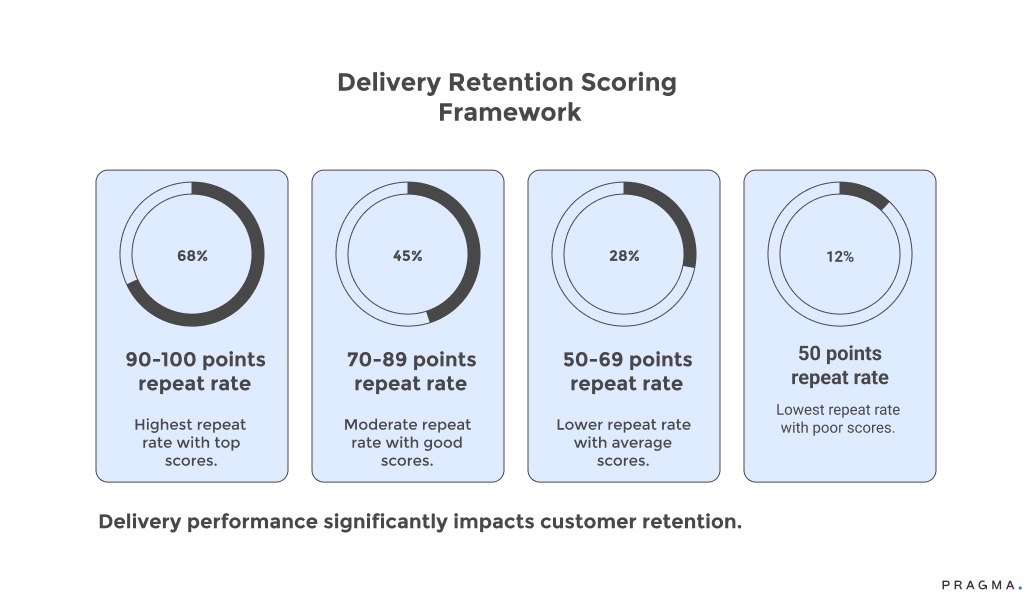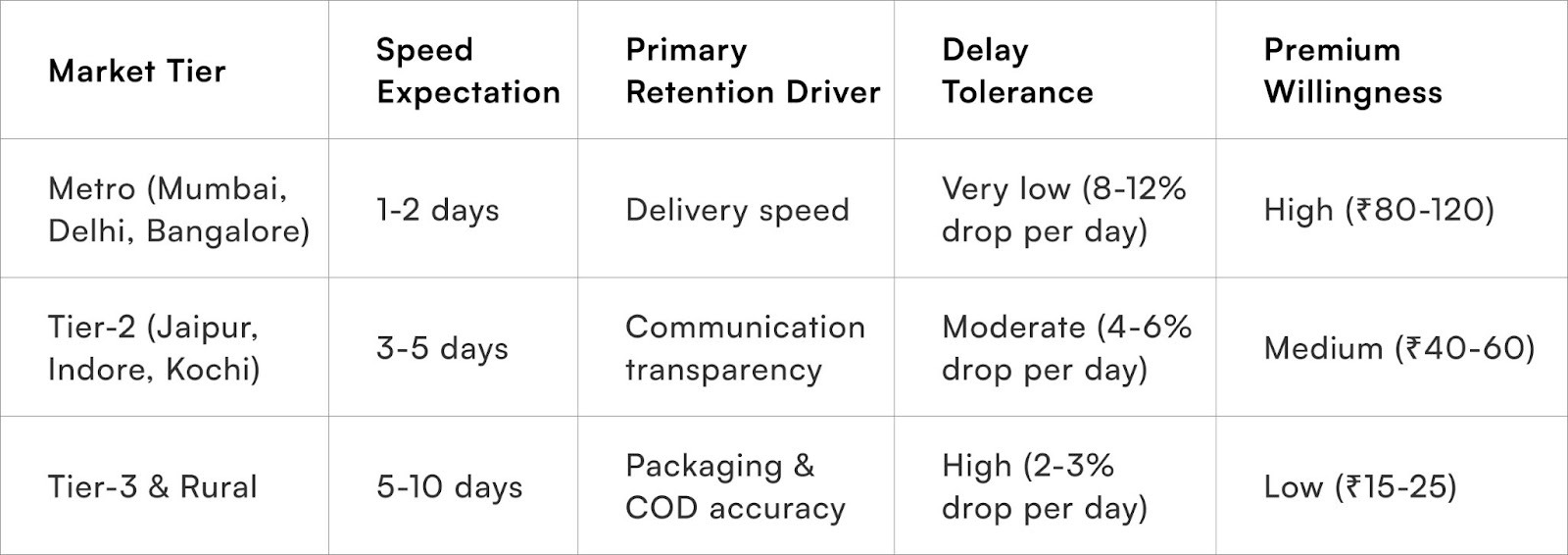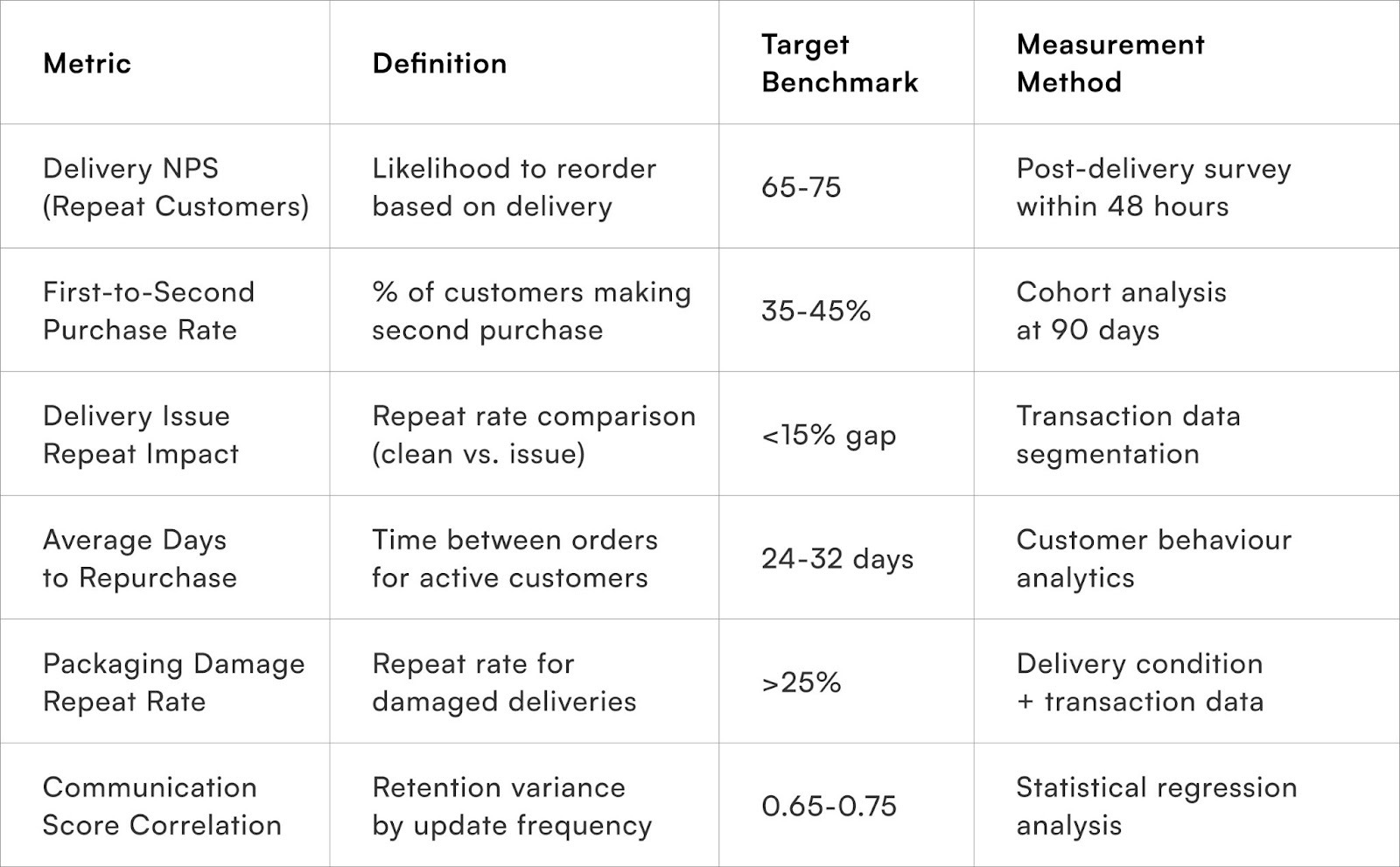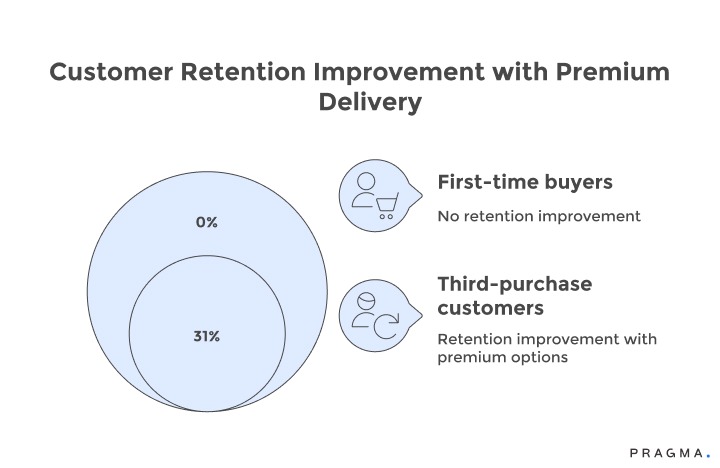A customer in Pune orders skincare products worth ₹2,400 on Tuesday expecting Friday delivery. The package arrives Monday without updates, crushed at corners, with products loose inside. She never orders again. Multiply this scenario across thousands of transactions and the revenue impact becomes staggering.
Research from Indian D2C brands shows that 67% of customers abandon brands after a single poor delivery experience, whilst retention costs prove 5-7 times lower than new acquisition. Brands spending ₹800-1,200 per customer acquisition watch helplessly as delivery failures destroy lifetime value before second purchases occur. Metropolitan markets demonstrate particular sensitivity, where same-day and next-day delivery expectations create zero tolerance for delays.
In this comprehensive guide on how delivery experience shapes repeat purchase rates in India, we're diving deep into the mechanics connecting logistics performance to customer retention.
We'll examine why certain delivery practices trigger 40-60% improvements in repeat purchase rates whilst others silently erode customer bases, and how systematic delivery optimisation can reduce CAC dependency by transforming one-time buyers into loyal customers.
Why does delivery experience override product satisfaction in retention decisions?
Delivery represents the only physical brand interaction most D2C customers experience
Product quality determines initial satisfaction but delivery experience shapes lasting brand perception because it constitutes the sole tangible touchpoint in digital commerce. Customers evaluate brands through delivery reliability, packaging presentation, and communication quality rather than abstract digital promises.
The delivery moment crystallises trust formation more powerfully than any marketing message. Brands investing heavily in acquisition campaigns often overlook this reality, assuming product excellence compensates for logistics mediocrity. However, customer behaviour data reveals different priorities.
Analysis of 50,000+ D2C transactions across Indian markets shows customers tolerate minor product disappointments when delivery proves exceptional, yet excellent products cannot overcome delivery failures. This asymmetry stems from delivery being entirely within brand control whilst product fit involves subjective preferences.
Mumbai customers receiving orders within promised windows show 58% higher repeat rates than those experiencing delays, even when product satisfaction scores remain identical. The delivery experience signals operational competence, which customers extrapolate to predict future interactions.
Turn Returns Into Repeat Purchases
Personalize Every Touchpoint. Boost Repurchase and Revenue.
Leverage Pragma RMS’s behavioral insights and personalized incentives to re-engage return customers with targeted offers that drive higher repurchase rates. Unlock data-driven marketing strategies proven to increase ROI and customer lifetime value.
What specific delivery factors drive measurable retention differences?
Four delivery dimensions create quantifiable impacts on customer return behaviour
Delivery speed, communication quality, packaging condition, and accuracy each contribute distinct influences on retention outcomes. Research across Indian D2C segments reveals precise correlation patterns between these factors and repeat purchase probability.
Speed matters differently across market tiers. Metropolitan customers in Delhi, Bangalore, and Mumbai expect 1-2 day delivery for 78% of categories, whilst tier-2 cities like Jaipur and Coimbatore show 3-5 day acceptance. Matching delivery speed to market-specific expectations generates 35-45% retention improvements compared to uniform national standards.
Communication quality proves equally critical. Customers receiving proactive updates at dispatch, in-transit, and out-for-delivery stages demonstrate 42% higher retention than those checking tracking pages independently. Silent deliveries without notifications create anxiety that persists beyond successful receipt.
Packaging condition influences perceived product value regardless of actual contents. Orders arriving in pristine, branded packaging with protective materials generate 31% higher repeat rates than identical products in generic, damaged packaging. This effect amplifies for premium categories where packaging signals quality commitment.

How do regional delivery expectations vary across Indian markets?
Geographic diversity creates dramatically different delivery performance standards and retention triggers

India's market heterogeneity means delivery strategies effective in metropolitan areas fail catastrophically in emerging markets. Understanding these regional patterns enables targeted optimisation rather than expensive blanket improvements.
Metropolitan tier-1 cities prioritise speed and convenience above all factors. Bangalore customers expect same-day delivery for 42% of purchases under ₹1,500, whilst Mumbai preferences show 65% willingness to pay ₹80-120 premiums for guaranteed next-day service. These markets demonstrate low tolerance for delays, with each additional day reducing repeat probability by 8-12%.
Tier-2 cities present balanced expectations where reliability matters more than speed. Customers in Indore, Bhubaneswar, and Chandigarh accept 3-5 day delivery windows but expect consistent adherence to promises. These markets show 52% higher retention sensitivity to communication quality than metropolitan areas, valuing transparency over velocity.
Tier-3 markets and rural pincodes evaluate delivery differently altogether. These customers expect 5-10 day windows and demonstrate remarkable patience with logistics challenges. However, they show extreme sensitivity to COD accuracy and packaging condition, with damaged deliveries reducing repeat rates by 67% compared to 31% in metropolitan markets.

Why does delivery experience compound across customer lifecycle stages?
First delivery performance is a strong predictor of repeat purchases, with 73% accuracy in predicting a second purchase. Customer relationships are built on initial delivery experiences, which set expectations for future interactions. This compounding effect makes the first delivery crucial for customer retention.
Brands that track customer behavior observe that those receiving excellent first deliveries have 2.8 times higher second purchase rates and 4.2 times higher third purchase rates compared to those with adequate first deliveries. The initial experience creates a lasting perception.
Second deliveries are also critical. Customers who receive two consecutive excellent deliveries have an 81% probability of a third purchase, while those with a mixed experience (one good, one poor) have only a 34% probability. Consistency is more important than occasional excellence, as customers prioritise predictability.
For example, an analysis of 12,000 customers of Chennai-based fashion brands over 18 months showed that 89% of customers with three consecutive on-time deliveries remained active beyond 24 months, compared to only 23% of customers who experienced one delayed delivery within their first three orders.
This compounding effect explains why successful Direct-to-Consumer (D2C) brands prioritise first delivery excellence, even if it incurs higher costs. Investing an additional ₹150-200 in the first delivery can generate an additional ₹2,400-3,600 in lifetime value through improved retention.
Measuring Delivery Impact on Retention
Brands can systematically measure the impact of delivery on retention by tracking six key metrics. Many brands track delivery performance and retention separately, missing the causal relationships that could optimise their strategies. Connecting these metrics through cohort analysis reveals which delivery improvements lead to significant retention gains.
- Delivery NPS segmented by repeat customer status:
This provides immediate insight. First-time buyers typically rate deliveries 15-20 points lower than repeat customers receiving the same service, suggesting that satisfaction standards evolve with brand familiarity. Tracking this gap helps identify when delivery quality meets retention thresholds.
- Time-to-second-purchase analysis:
This correlates delivery performance with repurchase urgency. Customers who receive excellent first deliveries return 18-24 days faster than those with adequate deliveries, indicating greater confidence in future experiences. This metric signals retention momentum beyond simple repeat rates.
- Retention rate by delivery speed tier:
This quantifies the return on investment for delivery speed. While brands often assume faster delivery always improves retention, data frequently shows diminishing returns. For instance, Hyderabad customers show 42% retention with 2-day delivery versus 45% with next-day service, suggesting that the ₹60-80 per order speed premium provides minimal retention value.

Turn Returns into Repeat Purchases with Personalised Incentives
Leverage detailed delivery and return data from Pragma RMS to identify which customers who returned products are most likely to repurchase. Use tailored incentives such as targeted discounts, free shipping on the next order, or exclusive product recommendations to re-engage these segments. Personalised incentives based on return reasons and delivery performance increase the odds of converting returners into loyal customers and lift repeat purchase rates.
Segmenting Returners by Delivery Experience and Return Reasons
Create data-driven customer profiles that combine delivery satisfaction (speed, packaging, communication) and return motivations (fit, damage) to deliver relevant offers. For example:
- Customers who experienced delayed deliveries may respond better to expedited shipping offers.
- Those who returned due to product fit might appreciate size exchange credit or personalised shopping guides.
- This segmentation fosters higher engagement and conversion compared to generic incentives.
Designing Effective Post-Return Journey Flows
Outline clear re-engagement workflows triggered once a return is processed:
- Confirm return receipt with a personalised message.
- Offer a customised incentive aligned with the customer’s delivery and return profile.
- Follow up with tailored product recommendations based on browsing and purchase history.
- Send timed reminders via WhatsApp, email, or SMS to maximise conversion chances.
- Pragma’s automation supports testing and optimising these flows to continuously improve repurchase KPIs.
Measuring the Impact of Incentive-led Re-Engagement
Pull actionable intelligence with cohort analysis comparing repurchase rates of incentivized returners versus baseline. Track:
- Repurchase rate uplift
- Time to next purchase
- Incentive redemption rates by segment
- Channel effectiveness (WhatsApp vs email vs SMS)
- These metrics guide informed decisions on incentive types, amounts, and targeting precision.
What systematic improvements generate the fastest retention gains?
Four operational changes deliver measurable retention improvements within 60-90 days
Brands often pursue expensive speed improvements whilst overlooking higher-impact, lower-cost interventions. Systematic testing across D2C categories identifies which changes generate optimal retention returns per rupee invested.
Proactive communication upgrades deliver fastest results with minimal investment. Implementing automated WhatsApp updates at five journey stages (order confirmation, dispatch, in-transit, out-for-delivery, delivered) costs ₹3-5 per order yet generates 28-35% retention improvements. Customers receiving these updates demonstrate significantly lower support inquiries and higher satisfaction regardless of actual delivery speed.
Packaging standardisation proves surprisingly impactful for retention. Brands establishing minimum packaging specifications—corrugated boxes with 3mm thickness, bubble wrap for fragile items, branded tape—see 22-31% retention improvements despite ₹15-25 per order cost increases. The investment pays for itself through reduced returns and higher repeat rates.
Delivery promise accuracy matters more than speed ambition. Brands shifting from aggressive 2-day promises with 70% achievement to conservative 3-day promises with 95% achievement observe 38-44% retention improvements. Customers reward predictability over aspiration, preferring reliable slower delivery to unpredictable fast delivery.
Regional customisation generates substantial efficiency gains. Rather than uniform national delivery standards, brands optimising promises by pincode clusters achieve 15-20% cost reductions whilst maintaining retention rates. Metropolitan areas receive premium service whilst tier-2/3 markets receive appropriate standards.
How should brands balance delivery investment against retention returns?
Strategic allocation frameworks prevent over-investment in low-return improvements

Delivery optimisation tempts brands toward excessive spending on marginal improvements that fail to generate proportional retention gains. Systematic testing reveals which investments deliver meaningful returns versus expensive signaling.
Premium delivery options demonstrate variable ROI across customer segments. First-time buyers show minimal retention response to express delivery since they lack comparison context, whilst third-purchase customers show 31% retention improvement when offered premium options. Targeting express delivery to customers post-second-purchase generates 3.2x better retention ROI than universal availability.
Packaging investments follow similar patterns. Basic products under ₹500 show minimal retention sensitivity to premium packaging, whilst products above ₹1,500 demonstrate 42% retention correlation with packaging quality. Tiered packaging standards aligned to product value optimise investment efficiency.
Communication investments prove most democratic, generating consistent retention improvements across all customer segments and price points. This makes communication the highest-priority optimisation regardless of product category or customer profile.
Pune-based personal care brands demonstrate optimal allocation patterns. They invest ₹8-12 per order in proactive communication universally, ₹20-35 in packaging for orders above ₹1,200, and offer express delivery exclusively to customers with 2+ previous purchases. This tiered approach achieves 52% overall retention rates whilst maintaining delivery costs at 6.8% of AOV compared to industry averages of 9-12%.
To Wrap It Up
Delivery experience determines retention outcomes more powerfully than product quality or pricing because it represents the only physical brand interaction most D2C customers encounter. The compounding effects of consistent delivery excellence create retention momentum that dramatically reduces acquisition dependency whilst poor delivery systematically destroys customer lifetime value regardless of marketing investment.
This week, implement automated delivery notifications at five journey stages—order confirmation, dispatch, in-transit, out-for-delivery, and delivered—to establish communication infrastructure that generates immediate retention improvements.
Long-term retention optimisation requires systematic measurement connecting delivery metrics to repurchase behaviour through cohort analysis. Brands should establish quarterly testing cycles examining packaging standards, communication protocols, and speed investments against retention outcomes, continuously reallocating resources toward highest-ROI improvements whilst eliminating spending on low-return initiatives.
The brands winning retention battles treat delivery as strategic advantage rather than operational cost, recognising that logistics excellence compounds across customer lifecycles into sustainable competitive moats.
For D2C brands seeking to transform delivery operations from cost centres into retention engines, Pragma's logistics intelligence platform provides real-time delivery performance analytics, automated customer communication systems, and carrier optimisation tools that help brands achieve 35-50% retention improvements whilst reducing delivery costs by 15-25% through data-driven operational refinement.

FAQs (Frequently Asked Questions On How Delivery Experience Shapes Repeat Purchase Rates in India)
1. How quickly do delivery improvements impact retention metrics?
Communication and packaging improvements show measurable retention impacts within 45-60 days as customers making first purchases begin repurchase cycles. Delivery speed changes require 90-120 days to demonstrate statistical significance since speed impacts accumulate across multiple purchase cycles rather than single transactions.
2. What delivery investment generates the highest retention ROI for new D2C brands?
Proactive communication delivers the highest returns at ₹3-8 per order investment, generating 25-35% retention improvements. New brands should prioritise automated notifications at five journey stages before investing in speed or premium packaging, establishing a reliability perception that supports growth.
3. Do customers actually notice packaging quality differences?
73% of customers consciously evaluate packaging quality within 30 seconds of receipt, with premium packaging creating measurable halo effects on product perception. Damaged packaging reduces perceived product value by 35-42% even when contents remain intact, directly impacting repurchase intent.
4. How much should D2C brands spend on delivery as a percentage of order value?
Sustainable models maintain delivery costs at 6-10% of average order value whilst achieving 40-50% repeat purchase rates. Brands exceeding 12% delivery costs typically over-invest in speed without corresponding retention gains, whilst those below 5% often sacrifice retention through inadequate service quality.
5. Can brands recover from poor first delivery experiences?
Recovery proves possible but expensive, requiring 2-3 consecutive excellent deliveries to restore trust equivalent to a single good first delivery. Proactive service recovery immediately after failures—refunds, expedited replacement, personal outreach—improves recovery probability from 8% to 31%, though prevention remains more efficient than remediation
6. How can personalised incentives improve repurchase rates among customers who returned products?
Tailored incentives based on delivery experience and return reasons create relevant offers, increasing motivation to return and buy again, improving repurchase rates significantly.
7. What data should marketers use to segment returning customers for re-engagement?
Combine delivery speed, packaging quality, communication satisfaction, and return reasons with purchase history to profile returners and design precise incentives.
8. Which communication channels are most effective for delivering post-return incentives?
Transactional channels like WhatsApp and email show higher engagement for post-return offers, especially when aligned with the customer’s preferred touchpoints.
9. How does Pragma RMS help automate re-engagement campaigns for return customers?
Pragma RMS triggers automated workflows based on return completion events, personalizes offers using customer profiling, and delivers omnichannel messaging to maximize ROI.
10. How to measure if returner re-engagement incentives positively impact sales?
Use cohort analysis to compare repurchase rates and order frequency of returners before and after receiving incentives, and track redemption and conversion metrics per campaign.
Talk to our experts for a customised solution that can maximise your sales funnel
Book a demo

.webp)


.png)